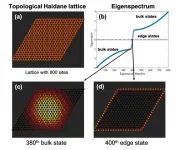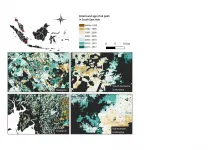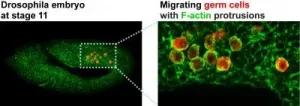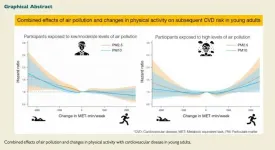(Press-News.org) HANOVER, N.H. - March 30, 2021 - Cyanobacteria living at the bottom of lakes may hold important, under-researched clues about the threat posed by these harmful organisms, according to a Dartmouth-led study.
The research, published in the Journal of Plankton Research, urges a more comprehensive approach to cyanobacteria studies in order to manage the dangerous blooms during a time of global climate change.
"Most studies of cyanobacteria focus on the times when they are visible in the water column," said Kathryn Cottingham, the Dartmouth Professor in the Arts and Sciences, and a professor of biology. "By concentrating on this part of the life cycle, we may be missing important clues about how these harmful organisms are responding to ongoing global change."
Also known as blue-green algae, blooms of cyanobacteria are increasing in many freshwater systems worldwide, damaging the quality of lake water and affecting lake communities. The blooms also threaten human health through toxins that can damage organ systems.
Cyanobacteria are complex, but researchers are bringing together clues on how they respond to changing seasons.
Freshwater cyanobacteria live either suspended in the water column or at the lake bottom depending, in part, on water temperature. During warmer months, suspended "pelagic" cyanobacteria thrive in warm, well-lit surface waters. In the fall, they sink to the bottom and spend the winter in a resting or fully dormant state.
The Dartmouth-led study focuses on how cyanobacteria behave around the bottom-dwelling "overwinter" period. The research stresses that the sediment-dwelling stage returns to the water column with higher water temperatures, often following the mixing of the water column. Climate change is decreasing some types of mixing but increasing others - such as that caused by extreme precipitation events.
According to the paper, if mixing is constrained and cyanobacteria are left at the bottom, blooms could decrease. "A more complete understanding of all stages of the cyanobacterial life cycle will enable plankton researchers to better predict how ongoing climate change will affect the frequency, intensity and duration of cyanobacterial blooms," the study said.
Land-use changes--such as deforestation, fertilizer use, and development--and climate change are considered the main drivers of cyanobacteria outbreaks. Although the precise causes of the blooms are still being studied, researchers believe that they come from ongoing increases in nutrient loading, temperature and precipitation.
"Our work indicates that cyanobacterial blooms could either increase or decrease as a result of climate change, necessitating preventative lake management to limit human health risks," said Cayelan Carey, associate professor of biological sciences at Virginia Tech and co-author on the study. "Avoiding fertilizer use and installing waterfront buffers can help decrease cyanobacteria, thereby providing 'insurance' against potential cyanobacteria increases due to warmer temperatures in the future."
The study focused on temperate lakes, but the research team stresses that other waterbodies should be include in the proposed research agenda.
Kathleen Weathers from the Cary Institute, and Holly Ewing and Meredith Greer from Bates College also contributed to the study.
INFORMATION:
As our planet warms, seas rise and catastrophic weather events become more frequent, action on climate change has never been more important. But how do you convince people who still don't believe that humans contribute to the warming climate?
New UBC research may offer some insight, examining biases towards climate information and offering tools to overcome these and communicate climate change more effectively.
Researchers examined 44 studies conducted over the past five years on the attentional and perceptual biases of climate change - the tendency to pay special attention to or perceive particular aspects of climate change. They identified a number of ...
UNIVERSITY PARK, Pa. -- A reproducibility crisis is ongoing in scientific research, where many studies may be difficult or impossible to replicate and thereby validate, especially when the study involves a very large sample size. For example, to evaluate the validity of a high-throughput genetic study's findings scientists must be able to replicate the study and achieve the same results. Now researchers at Penn State and the University of Minnesota have developed a statistical tool that can accurately estimate the replicability of a study, thus eliminating the need to duplicate the work and effectively ...
In a joint effort, researchers from the Humboldt-Universität (Berlin), the Max Born Institute (Berlin) and the University of Central Florida (USA), have revealed the necessary conditions for the robust transport of entangled states of two-photon light in photonic topological insulators, paving the way the towards noise-resistant transport of quantum information. The results have appeared in Nature Communications.
Originally discovered in condensed matter systems, topological insulators are two-dimensional materials that support scattering-free (uni-directional) transport along their edges, even in the presence of defects and disorder. In ...
IIASA researchers have used Sentinel 1 satellite imagery from the European Space Agency to produce a map of the extent and year of detection of oil palm plantations in Indonesia, Malaysia, and Thailand that will help policymakers and other stakeholders understand trends in oil palm expansion while also providing an accurate map for landscape-level planning.
The world's appetite for palm oil seems to know no bounds. We use it in everything from beauty products and food, to industrial processes and biofuels to fulfill our energy needs. This ever growing demand has caused oil palm production to more than double in the last two decades, a development which has in turn deeply impacted natural forest ecosystems and biodiversity, while also significantly ...
One in four Germans suffers from metabolic syndrome. Several of four diseases of affluence occur at the same time in this 'deadly quartet': obesity, high blood pressure, lipid metabolism disorder and diabetes mellitus. Each of these is a risk factor for severe cardiovascular conditions, such as heart attack and stroke. Treatment aims to help patients lose weight and normalise their lipid and carbohydrate metabolism and blood pressure. In addition to exercise, doctors prescribe a low-calorie and healthy diet. Medication is often also required. However, it is not fully clear ...
Researchers at KU Leuven (Belgium) have succeeded for the first time in measuring brain waves directly via a cochlear implant. These brainwaves indicate in an objective way how good or bad a person's hearing is. The research results are important for the further development of smart hearing aids.
A cochlear implant enables people with severe hearing loss to hear again. An audiologist adjusts the device based on the user's input, but this is not always easy. Think of children who are born deaf or elderly people with dementia. They have more difficulty assessing and communicating ...
Artificial Intelligence is now capable of generating novel, functionally active proteins, thanks to recently published work by researchers from Chalmers University of Technology, Sweden.
"What we are now able to demonstrate offers fantastic potential for a number of future applications, such as faster and more cost-efficient development of protein-based drugs," says Aleksej Zelezniak, Associate Professor at the Department of Biology and Biological Engineering at Chalmers.
Proteins are large, complex molecules that play a crucial role in all living cells, building, modifying, and breaking down other molecules naturally inside our cells. They are also widely used in industrial processes and products, and in our daily lives.
Protein-based drugs are very common - the diabetes drug ...
Working with fruit flies, scientists at Johns Hopkins Medicine say they have identified a new molecular pathway that helps steer moving cells in specific directions. The set of interconnected proteins and enzymes in the pathway act as steering and rudder components that drive cells toward an "intended" rather than random destination, they say.
In a report on the work, published March 2 in Cell Reports, these same molecular pathways, say the scientists, may drive cancer cells to metastasize or travel to distant areas of the body and may also be important for understanding how cells assemble and migrate in an embryo to form organs and other structures.
The team of scientists was led by Deborah Andrew, Ph.D., professor of cell biology and associate director for faculty development for ...
Physical activity is important in preventing heart and blood vessel disease in young people so long as they don't undertake very strenuous activity on days when air pollution levels are high, according to a nationwide study of nearly 1.5 million people published today (Tuesday) in the European Heart Journal [1].
Until now, little has been known about the trade-offs between the health benefits of physical activity taking place outdoors and the potentially harmful effects of air pollution. Previous research by the authors of the current study had investigated the question in middle-aged people at a single point in time, but this is the first time that it has been investigated in people aged between 20-39 years over a period of several years. In addition, the researchers wanted to ...
Scientists have identified three genes associated with an increased risk of developing cervical cancer.
The study, led by scientists from Imperial College London and published in the journal The Lancet Oncology, studied data from over 150,000 European women.
The research is one of the first studies to pinpoint genetic variants associated with an increased risk of cervical precancer and cancer.
The study team say the findings open avenues for identifying women at higher risk and monitoring their health more closely - particularly if genetic information is ...





